Welcome to “15 Stunning Mid-Century Modern Interior Tips,” where the timeless elegance of the past meets the vibrant creativity of today. Whether you’re a novice just dipping your toes into the world of interior design or a seasoned decorator seeking fresh inspiration, this guide is your ticket to transforming any space with the iconic allure of mid-century modern style.
In this collection, you’ll discover not just ideas, but practical techniques that will effortlessly elevate your home. These tips hold the power to infuse your living space with both functionality and sophistication, ensuring that every room is a reflection of your personal taste and flair.
Embarking on a design journey should be as rewarding as it is enjoyable, and we’re here to ensure you feel confident and inspired every step of the way. So, roll up your sleeves and get ready to unlock the secrets of mid-century modern design, blending classic charm with contemporary comfort in a way that’s uniquely yours.
Incorporate Iconic Furniture Pieces
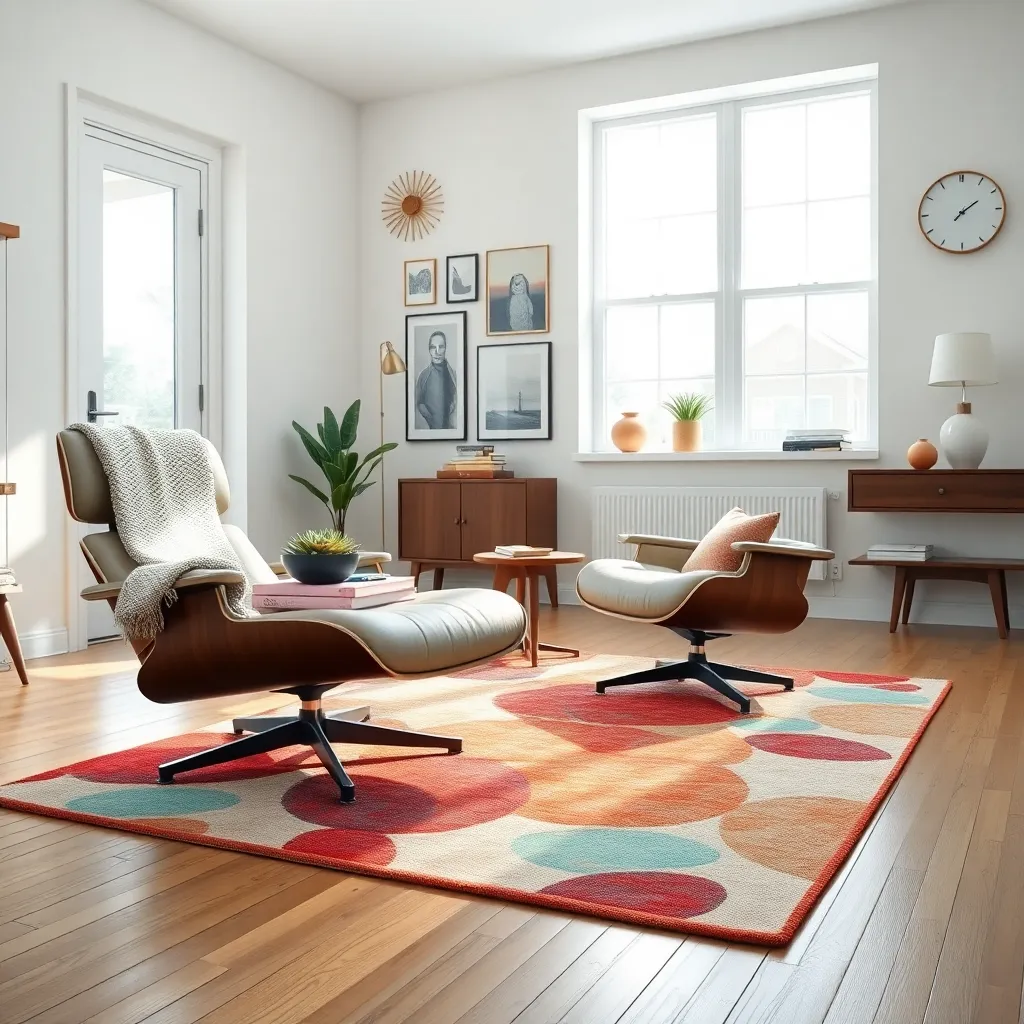
Incorporating iconic mid-century modern furniture pieces can instantly elevate your space with a timeless aesthetic. Start by selecting a piece like the Eames Lounge Chair, known for its luxurious comfort and sophisticated design, to serve as a focal point in your living room.
Another classic option is the Noguchi Coffee Table, which pairs beautifully with various seating arrangements due to its minimalist form and organic shape. Place it centrally in your seating area to allow its sculptural base to catch the eye, and consider pairing it with a soft, neutral-toned rug to enhance its sleek lines.
For those looking to add a touch of elegance to their dining area, the Saarinen Tulip Table provides a seamless blend of form and function. Pair it with chairs in complementary hues, such as white or light gray, to maintain a harmonious and airy feel.
Advanced decorators might explore mixing and matching these iconic pieces with contemporary accents to create a personalized, eclectic vibe. Always ensure that the scale and proportion of each furniture piece complement your space, keeping the layout balanced and cohesive.
Emphasize Natural Wood Finishes
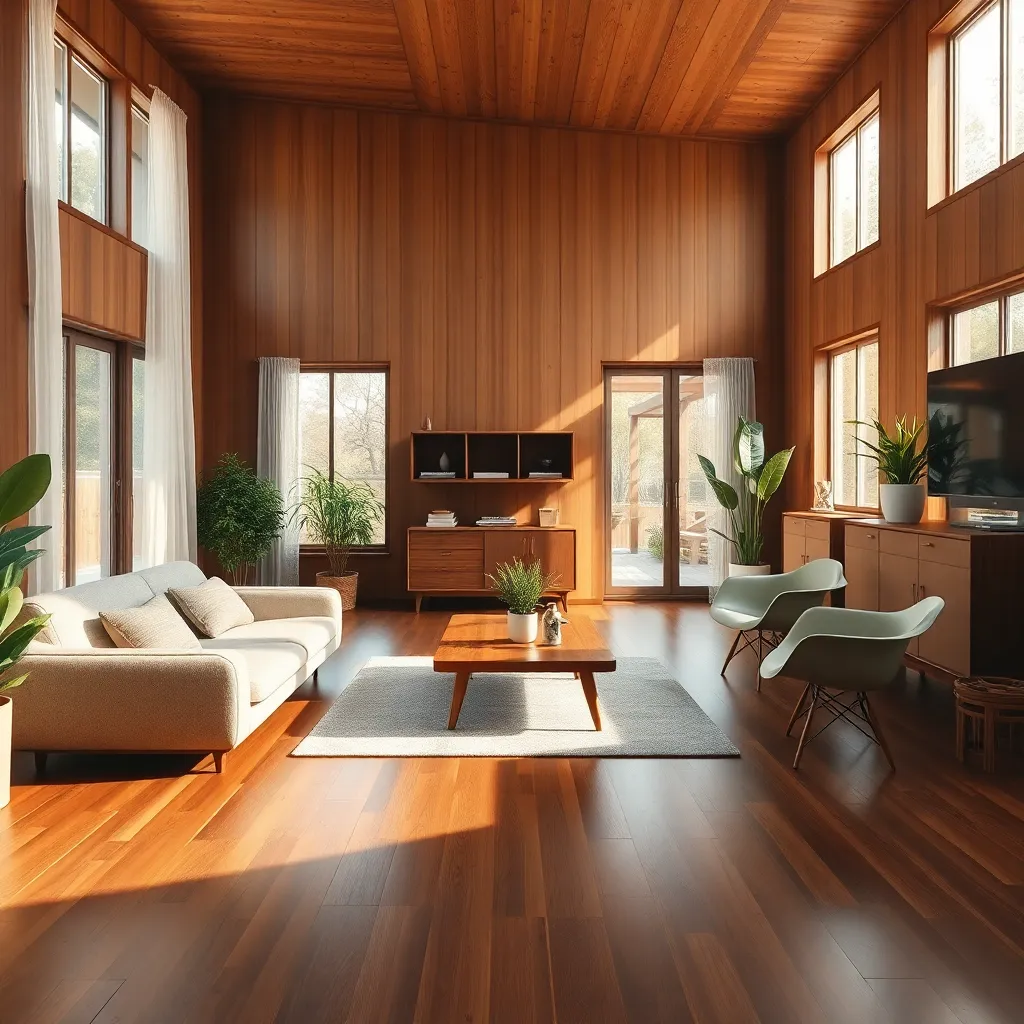
Natural wood finishes are a hallmark of the mid-century modern style, bringing warmth and texture into your space. Start by choosing furniture pieces like coffee tables or sideboards with exposed, rich wood grains, such as walnut or teak, for an authentic touch.
Incorporating wood elements isn’t just limited to furniture. Consider wooden wall panels or flooring to enhance your room’s character and create a cohesive look. Pair these with neutral or earthy tones—such as olive green or mustard yellow—to maintain the style’s natural appeal.
For beginners, focus on selecting simple wooden pieces with clean lines, which embody the mid-century ethos. Advanced decorators might experiment with mixing different wood finishes to add depth and interest, ensuring the undertones are harmonious.
Placement is key when working with natural wood finishes. Position wooden furniture to receive ample natural light, highlighting its grain and texture beautifully. Enhance the look with metallic accents—like a brass lamp or chrome-framed artwork—to create a balanced and stylish contrast.
Select Bold Geometric Patterns
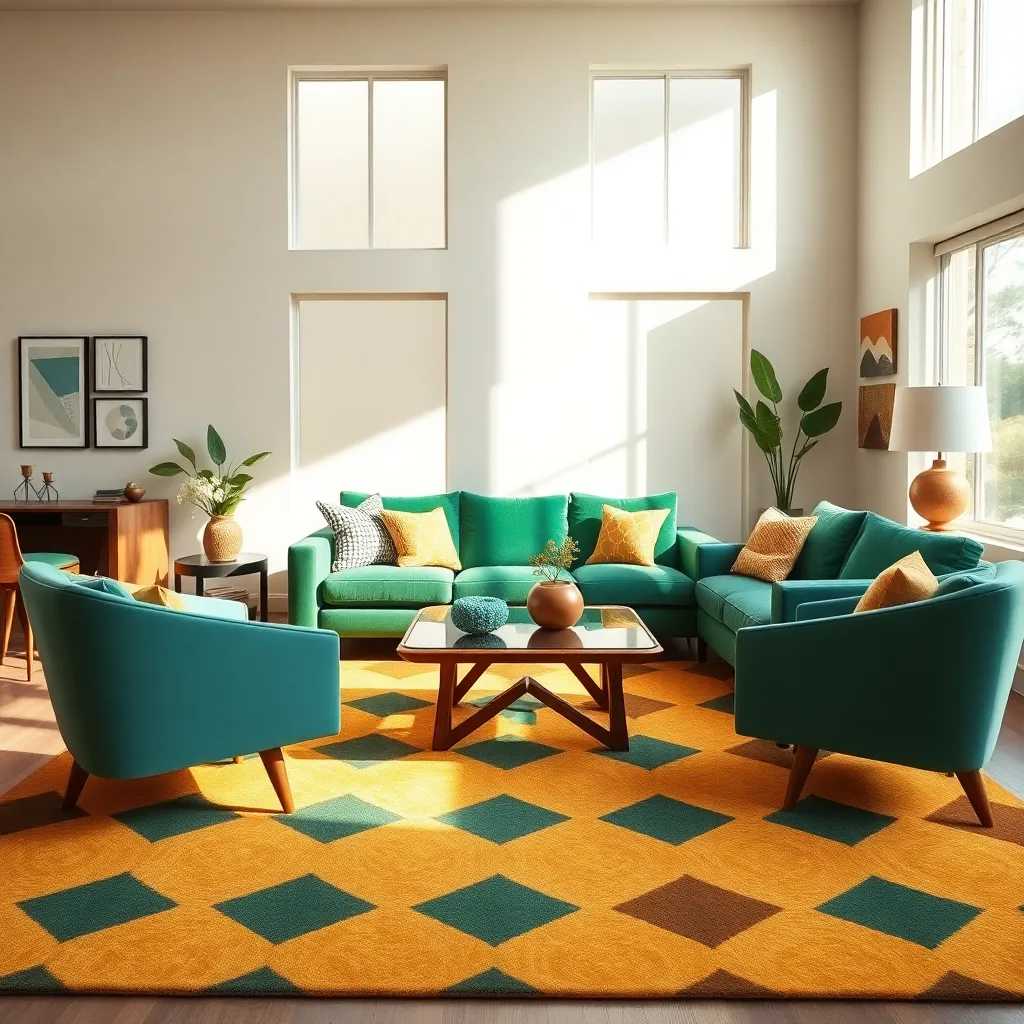
Incorporating bold geometric patterns into a mid-century modern space can create a striking focal point. Consider using a statement rug with a bold geometric design to anchor your living room, pairing it with more neutral furnishings to let the pattern shine.
Walls are another excellent canvas for geometric patterns. You can opt for a single accent wall with a bold geometric wallpaper, which adds depth and visual interest without overwhelming the entire room.
For a more subtle approach, introduce geometric patterns through textiles such as throw pillows or curtains. Choose patterns that have clean lines and vibrant colors to resonate with the mid-century modern aesthetic.
Advanced decorators might experiment with geometric patterns in furniture design. Selecting a piece like a side table or shelving unit with distinctive geometric shapes can add an unexpected and sophisticated twist to your space.
Use Earthy Color Palettes
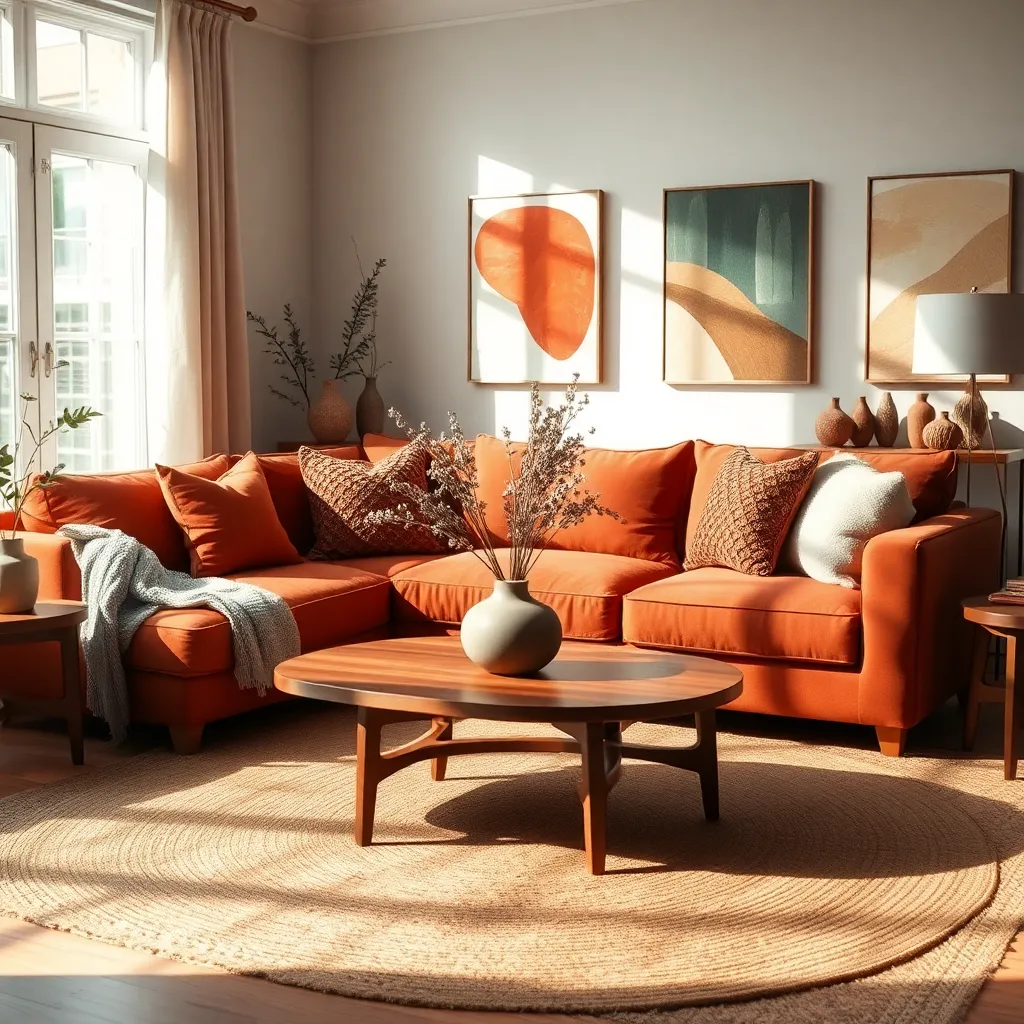
To bring a sense of tranquility and warmth into your mid-century modern space, consider using an earthy color palette. These colors, inspired by nature, include shades like terracotta, olive green, and mustard yellow, which can create a grounded and inviting atmosphere.
Start by incorporating these colors into your walls or furnishings for a subtle yet impactful change. For instance, a soft clay-colored accent wall can provide a perfect backdrop for showcasing your mid-century furniture.
Furniture pieces in rich wood tones, such as walnut or teak, naturally complement earthy hues and enhance the mid-century aesthetic. Pairing a walnut coffee table with a rust-colored sofa can create a cohesive look that is both stylish and comfortable.
For a more advanced touch, experiment with layering different textures in earthy tones, such as a jute rug or linen curtains. Adding these textures not only adds depth to your decor but also enhances the tactile experience of your living space.
Introduce Sculptural Lighting Fixtures

To elevate your mid-century modern space, consider incorporating sculptural lighting fixtures that double as art pieces. Select fixtures with unique shapes or materials like brass, glass, or wood to add an artistic flair to your decor.
When choosing sculptural lighting, focus on the balance and proportion within your room. A statement chandelier can anchor a dining area, while a sculptural floor lamp can highlight a seating nook.
For beginners, start with one standout piece to avoid overwhelming the space. Place a bold pendant light over a kitchen island or in an entryway to create a striking focal point that draws the eye.
Experienced decorators can experiment with layering different lighting styles. Combine wall sconces and table lamps with your sculptural centerpiece to create a cohesive yet dynamic lighting scheme that enhances both functionality and style.
Opt for Sleek, Low-Profile Sofas
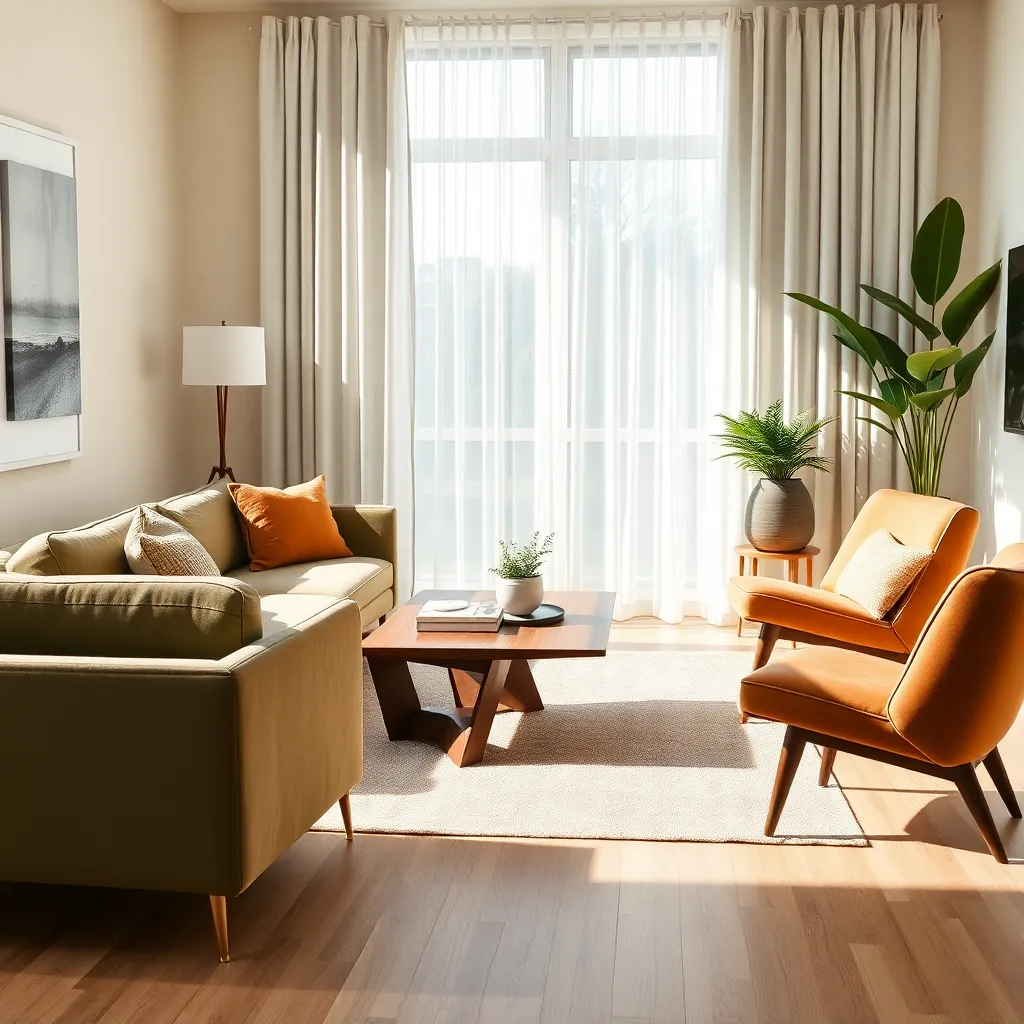
For a truly mid-century modern look, opt for sleek, low-profile sofas that embody the era’s minimalist ethos. These sofas typically feature clean lines and simple silhouettes, making them a timeless addition to any living room.
Consider choosing a sofa with tapered wooden legs to enhance the vintage appeal. Materials like leather or textured fabrics in subtle hues, such as muted grays or soft blues, work well to create a classic yet inviting atmosphere.
Placement is key—position your low-profile sofa to maintain an open and airy feel in the room. Aim to leave space around the sofa to avoid clutter, ensuring the area remains functional and visually appealing.
For a cohesive design, pair your sofa with a few well-chosen accessories such as a retro-inspired coffee table or a geometric rug. These elements will complement the sofa’s design and enhance the overall mid-century modern aesthetic.
Mix Materials for Visual Interest
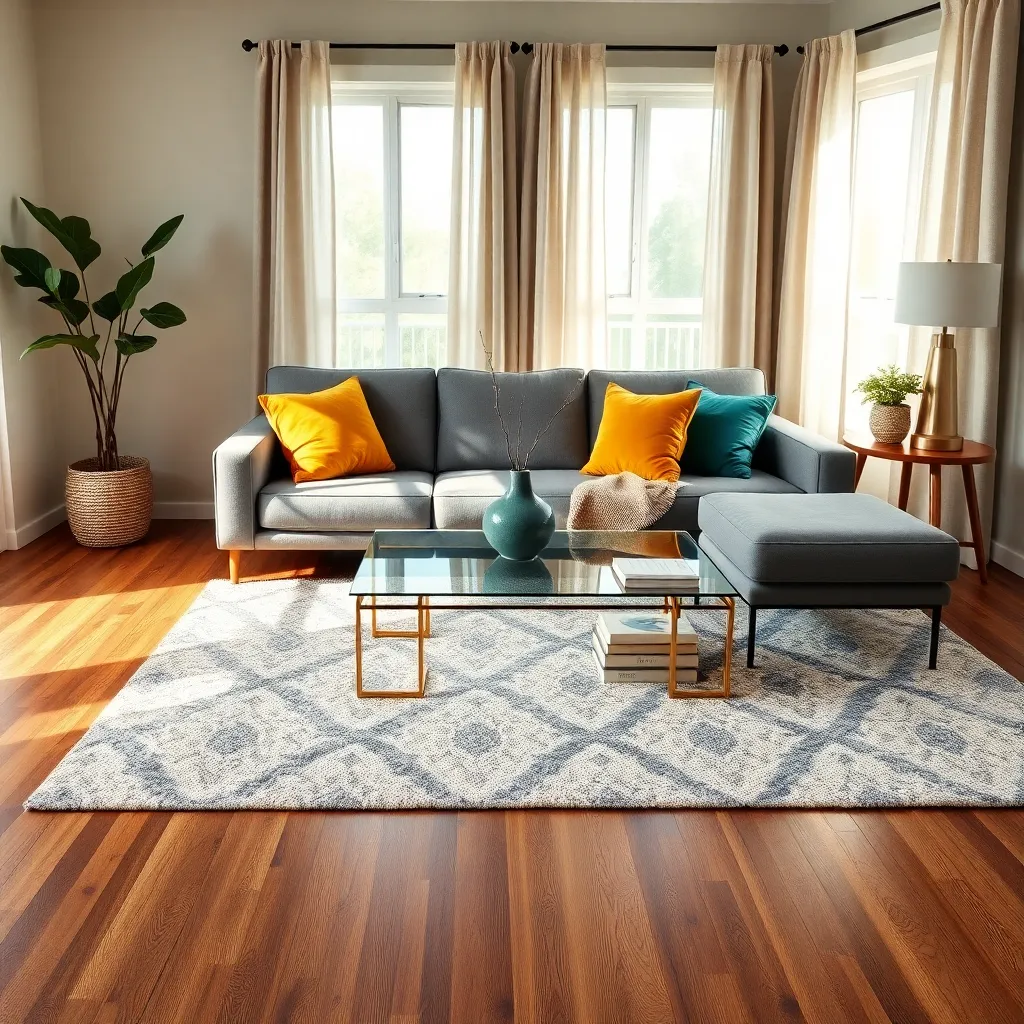
To create visual interest in a mid-century modern space, start by combining a variety of materials. Mixing wood, metal, and glass can give your interiors that signature mid-century flair while keeping the look fresh and dynamic.
Incorporate wood in the form of a walnut coffee table or a teak sideboard to bring warmth to the room. Pair these wooden elements with metallic accents such as brass light fixtures or chrome chair legs for a touch of elegance and modernity.
For a more advanced approach, consider adding textured materials like boucle or velvet to your furniture pieces. A boucle armchair can add a cozy texture, while a velvet cushion in a bold color like teal or mustard introduces a pop of color and sophistication.
Finally, don’t overlook the power of glass to enhance your space. Glass-topped tables or glass pendant lights can help maintain an open, airy feel, which is a hallmark of mid-century modern design. Strategically place these elements to catch and reflect natural light, enhancing the overall ambiance of the room.
Highlight Clean, Simple Lines
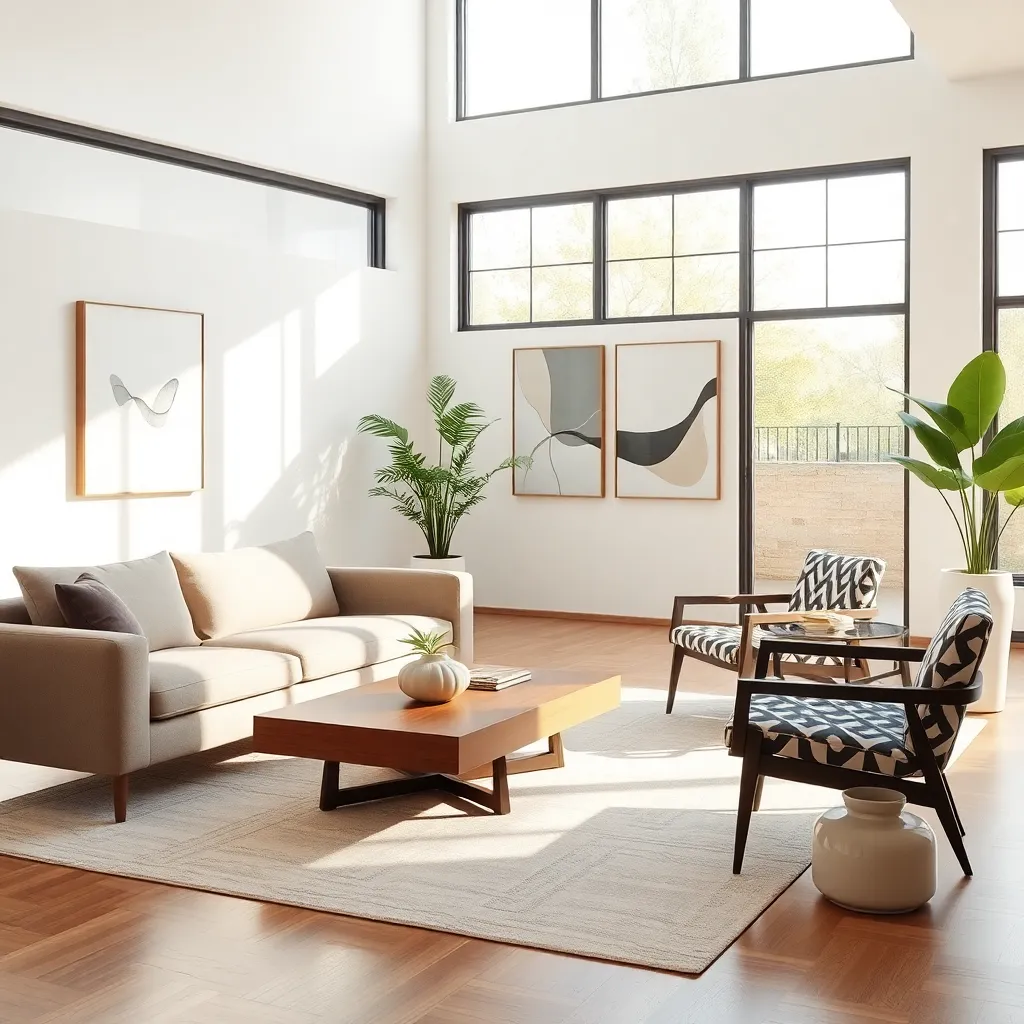
Achieving a mid-century modern aesthetic often starts with emphasizing clean, simple lines in your design. Choose furniture pieces with sleek silhouettes, such as a low-profile sofa or a streamlined dining table, to create a sense of order and elegance.
Incorporate angular shapes and smooth surfaces to maintain the minimalist essence. Opt for furniture with tapered legs and avoid overly ornate details, ensuring that every piece contributes to a cohesive and uncluttered look.
When selecting a color palette, focus on neutral tones like whites, greys, and beiges to highlight the simplicity of the design. Add strategic pops of color through accessories like cushions or artwork to maintain visual interest without overwhelming the space.
Advanced decorators might consider layering textures with materials like polished wood, chrome, or leather to add depth while maintaining clean lines. Arrange your furniture to create open pathways, allowing the eye to naturally flow through the space without obstruction.
Add Retro-Inspired Wall Art
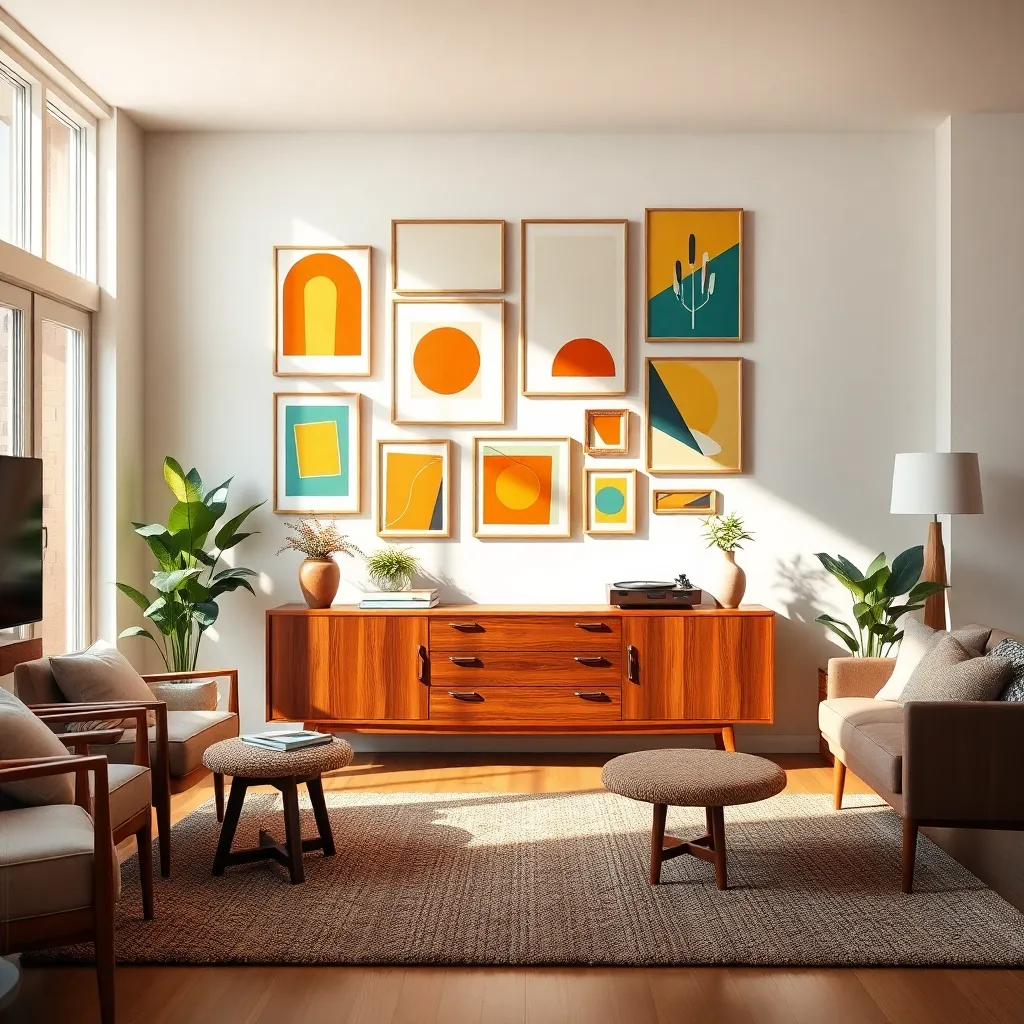
Incorporating retro-inspired wall art can add a vibrant touch to your mid-century modern interior. Opt for pieces with bold geometric patterns or abstract designs to capture the essence of the era.
When selecting wall art, consider the color palette of your space. Choose art that complements your existing decor, focusing on classic mid-century hues like mustard yellow, teal, and burnt orange.
Placement is key to maximizing the impact of your wall art. Hang pieces at eye level and consider grouping several smaller prints together for a gallery wall effect that radiates mid-century charm.
For those with a keen eye for detail, explore vintage shops or online marketplaces for authentic mid-century artwork. Reproductions are also a great choice if you’re aiming for a more budget-friendly option while still achieving the desired retro flair.
Integrate Vintage Accessories
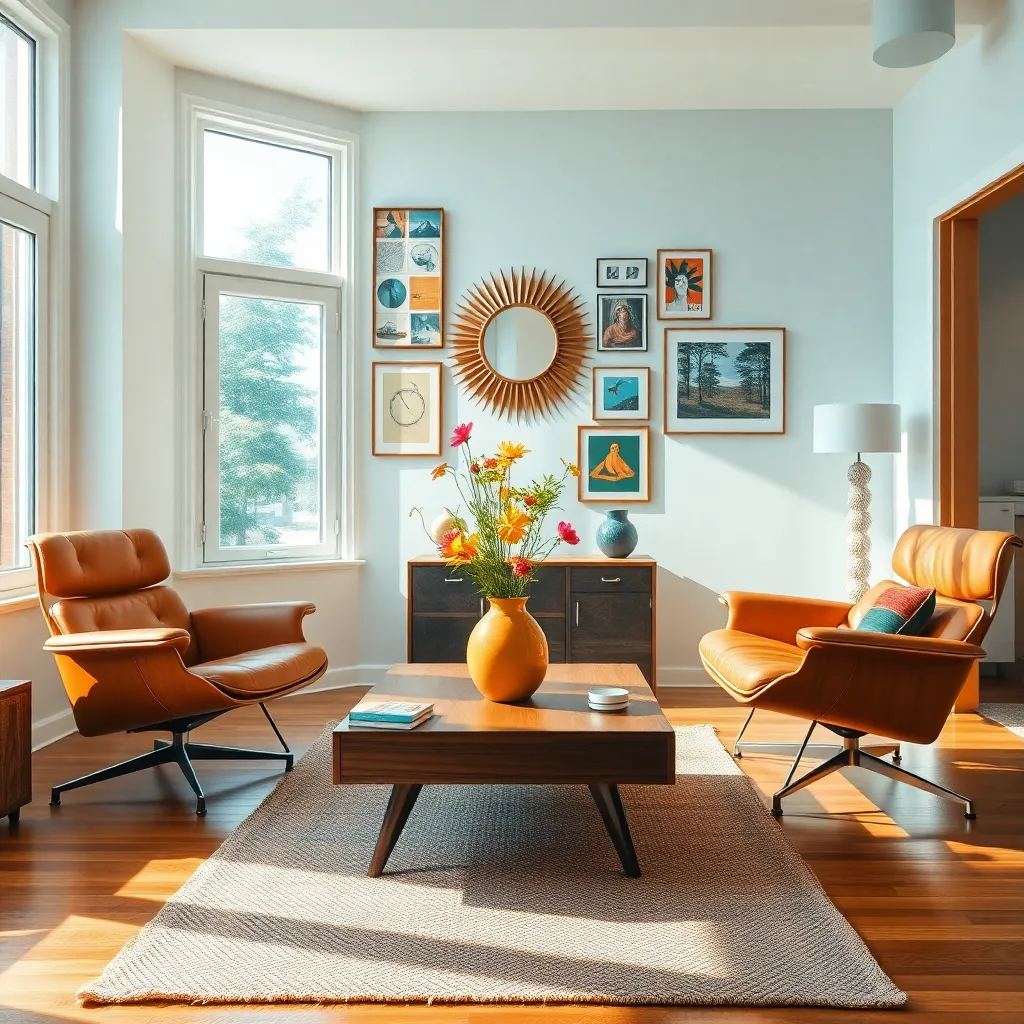
Integrating vintage accessories into a mid-century modern design can add depth and character to your space. Begin by selecting items that complement the era, such as a classic rotary phone or a sunburst clock, which can serve as striking focal points.
Consider incorporating vintage lighting fixtures, like an arc lamp or sputnik chandelier, to enhance the room’s ambiance. These pieces not only provide functional lighting but also act as conversation starters due to their distinctive designs.
For a more curated look, mix and match vintage textiles like throw pillows or rugs with modern furniture. Opt for bold geometric patterns or earthy tones to maintain the mid-century palette while adding texture and warmth.
Advanced decorators might explore vintage glassware or ceramics to display on open shelves or sideboards. These accessories can reflect your personal style and add a touch of nostalgia, making your space uniquely yours.
Choose Organic Shaped Rugs
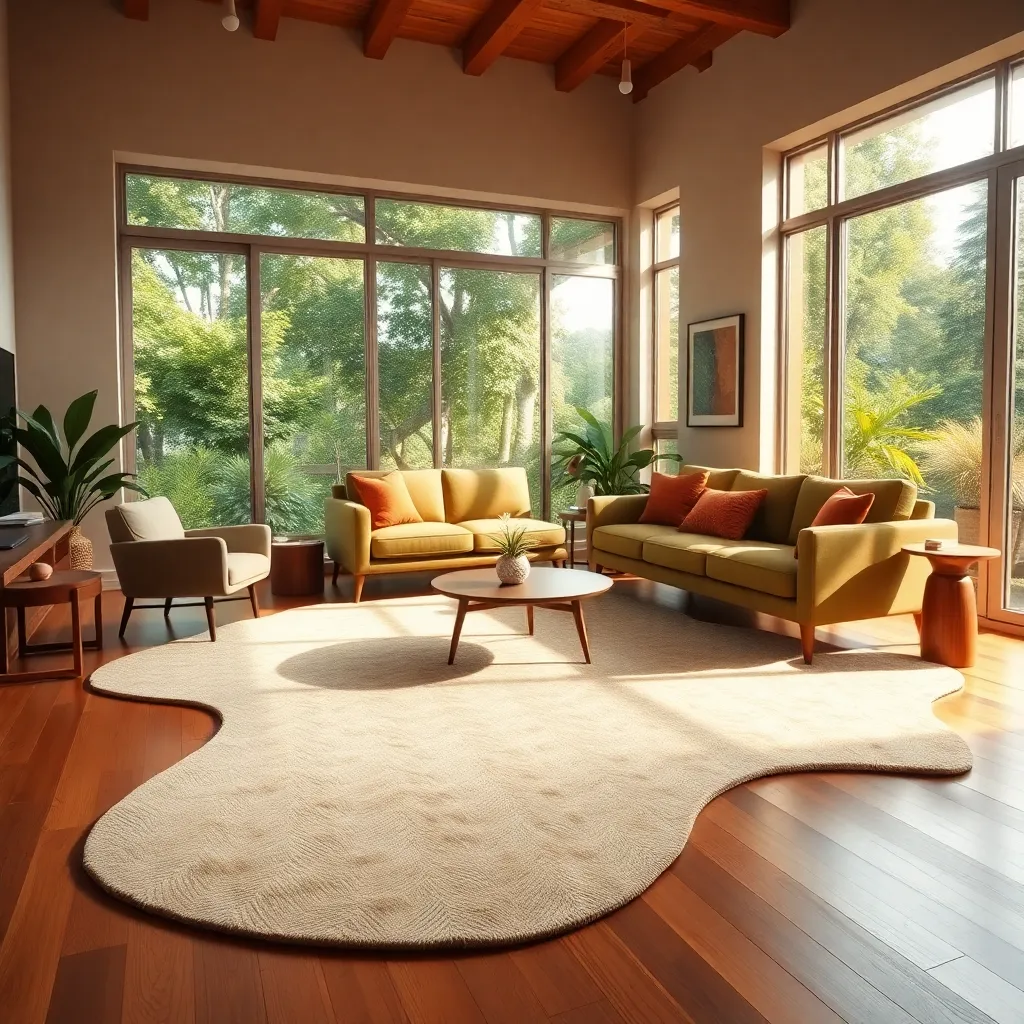
For a truly authentic mid-century modern vibe, consider incorporating organic shaped rugs into your space. These rugs, with their free-form curves and unique silhouettes, can break the monotony of straight lines often seen in furniture.
When choosing an organic shaped rug, opt for warm, earthy tones like rust, mustard, or olive to complement the natural wood finishes typical of this style. By doing so, you seamlessly blend the rug into the existing color palette, creating a cohesive look.
Placement is key to maximizing the impact of an organic shaped rug. Position it under a coffee table or partially beneath a sofa to highlight its asymmetrical contours, which can create a dynamic focal point in the living area.
For those with a more adventurous spirit, layer an organic shaped rug over a larger, neutral area rug. This technique adds texture and depth to the room, enhancing the visual interest without overwhelming the space.
Create Open, Airy Layouts
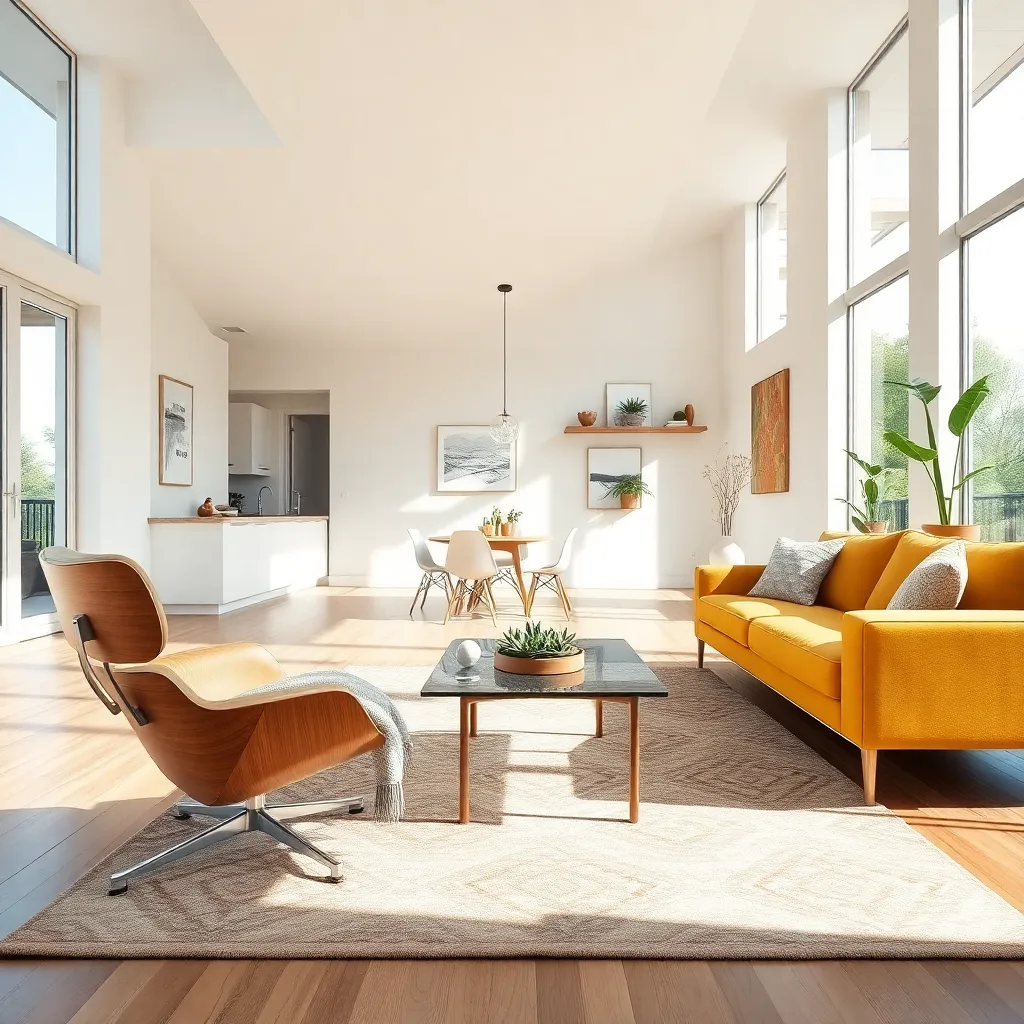
To create open, airy layouts, start by selecting furniture with clean lines and raised legs. This allows for a seamless flow of space and light, giving the illusion of a larger area. Opt for pieces like a sleek, low-profile sofa or a minimalist coffee table, which do not overwhelm the room. Keeping sightlines clear is essential; therefore, avoid bulky or dark furniture that can visually shrink your space.
Incorporate neutral color schemes to enhance the airy feel of your home. Soft whites, light grays, and beiges work well to reflect natural light and create a serene atmosphere. For more advanced decorators, consider an accent wall in a muted pastel or a subtle wallpaper with geometric patterns to add interest without overpowering the space. Using these colors on walls and larger furniture pieces helps maintain a cohesive and expansive look.
For a practical layout, arrange furniture to facilitate easy movement throughout the room. Place larger pieces against walls or in corners to open up central space, allowing for better flow. Use rugs to define areas within an open plan, like separating a living room from a dining area, which helps maintain a sense of orderliness while preserving openness. Make sure to leave pathways unobstructed to encourage a natural circulation and use of space.
Lastly, maximize natural light by using sheer curtains or blinds that can be easily adjusted. Reflective surfaces like mirrors or glass-topped tables can further amplify light, enhancing the open feel. Position mirrors opposite windows to bounce light around the room, a trick that both beginners and seasoned decorators can employ effectively. This not only brightens the space but also adds depth, making rooms appear larger and more inviting.
Layer Textures with Throws
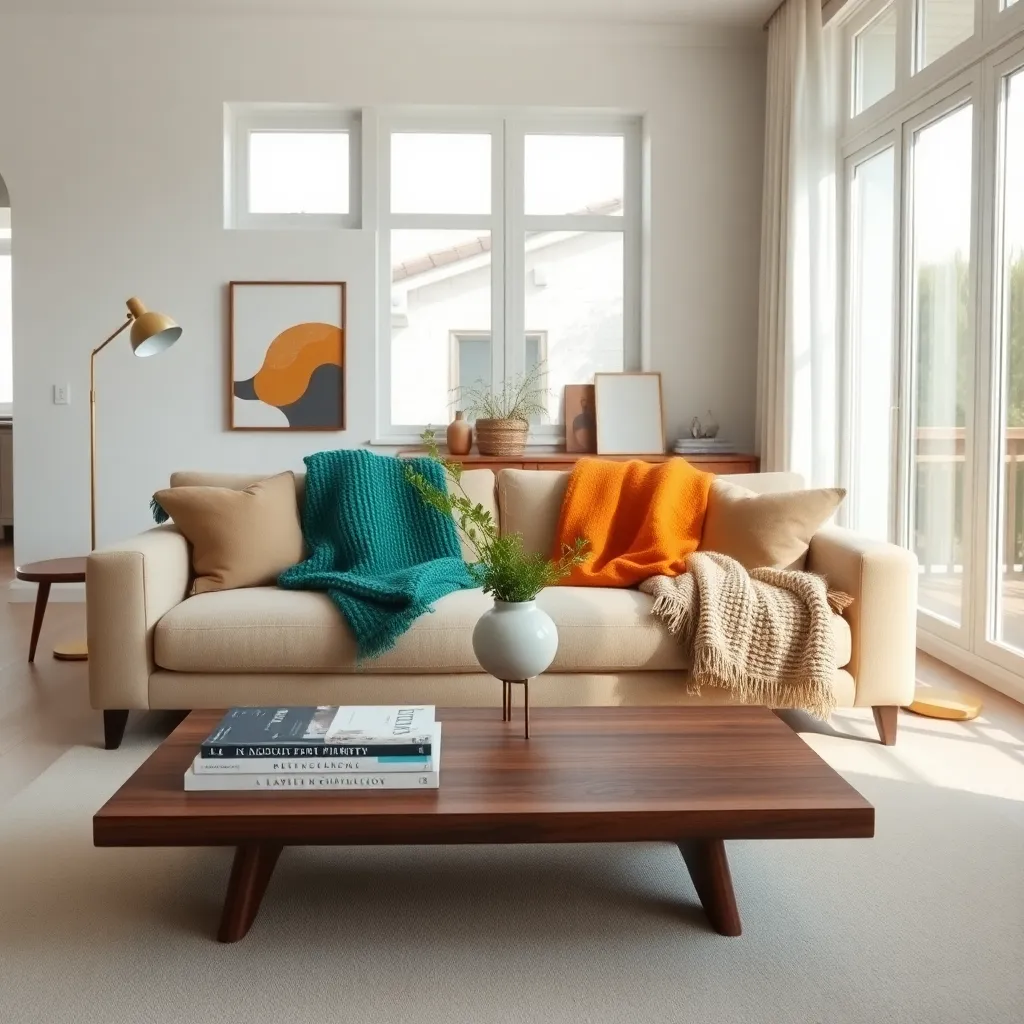
Layering textures with throws can transform your mid-century modern space into a cozy yet sophisticated retreat. Start by selecting throws in natural materials like wool, cotton, or linen to complement the mid-century aesthetic.
To add a pop of color, choose throws in bold hues such as mustard yellow or deep teal, which are iconic to the era. Drape these over a neutral-toned sofa or armchair to create a striking contrast without overwhelming the room.
For a more subtle approach, consider using throws in muted tones like gray or beige, which can seamlessly blend with existing decor. Mix and match textures by pairing a smooth wool throw with a chunky knit one, adding depth to your seating area.
Advanced decorators might experiment with patterned throws featuring geometric designs or abstract motifs. Place these throws strategically, folding them neatly on the back of a chair or loosely over a sofa arm, allowing them to become both functional and decorative elements.
Feature Statement-Making Planters
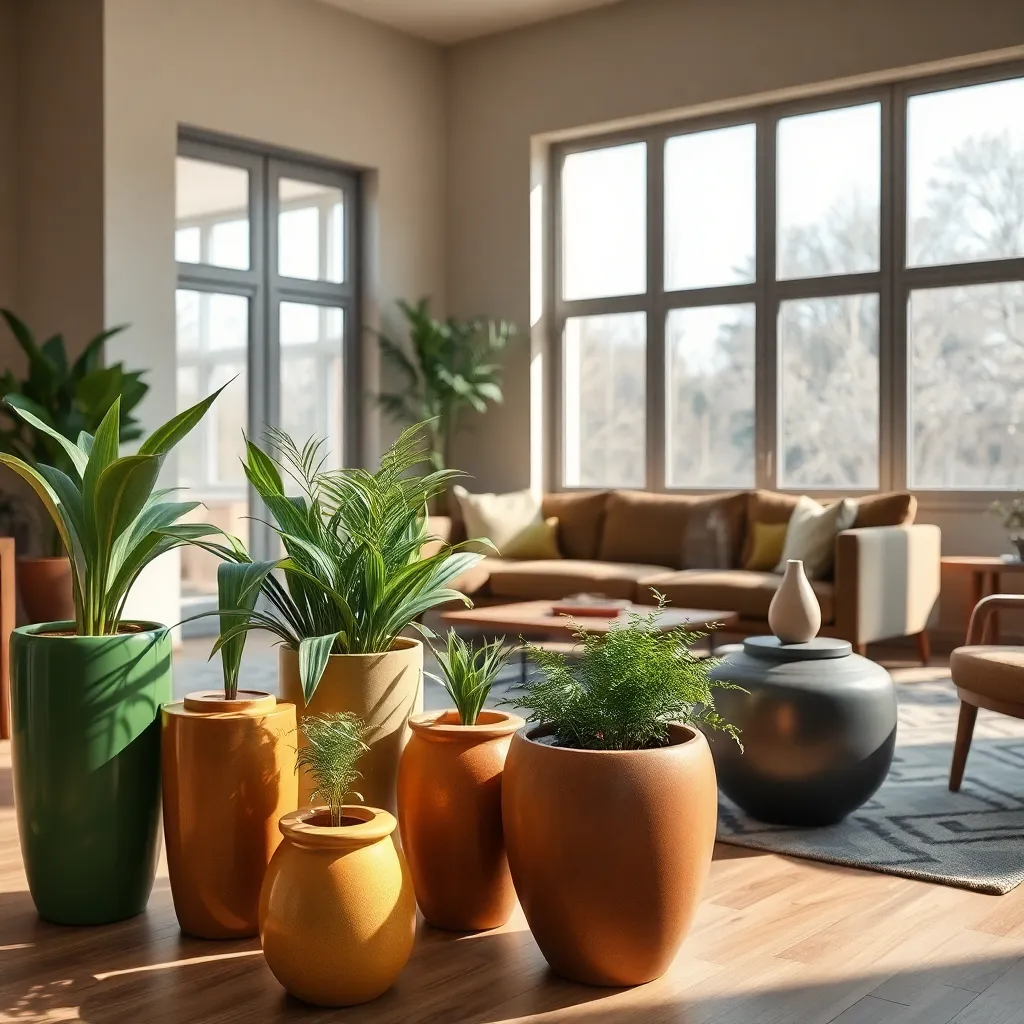
Adding feature statement-making planters is an excellent way to bring the essence of mid-century modern design into your home. Opt for bold, geometric-shaped planters in materials like ceramic or fiberglass to echo the era’s clean lines and innovative forms.
Place these planters strategically to create focal points that draw the eye and complement your existing furniture. For a balanced look, consider grouping planters of varying heights together, which can add visual interest and dimension to your space.
Choose plants that reflect the simplicity and elegance of mid-century modern design, such as snake plants, rubber plants, or fiddle leaf figs. These plants not only thrive indoors but also enhance the aesthetic with their sculptural leaves and rich green hues.
For a more advanced touch, match the planter color to an accent color within your space, such as a throw pillow or wall art. This creates a cohesive look that ties the room together, making your planters feel like an intentional part of the design rather than an afterthought.
Incorporate Large Glass Windows
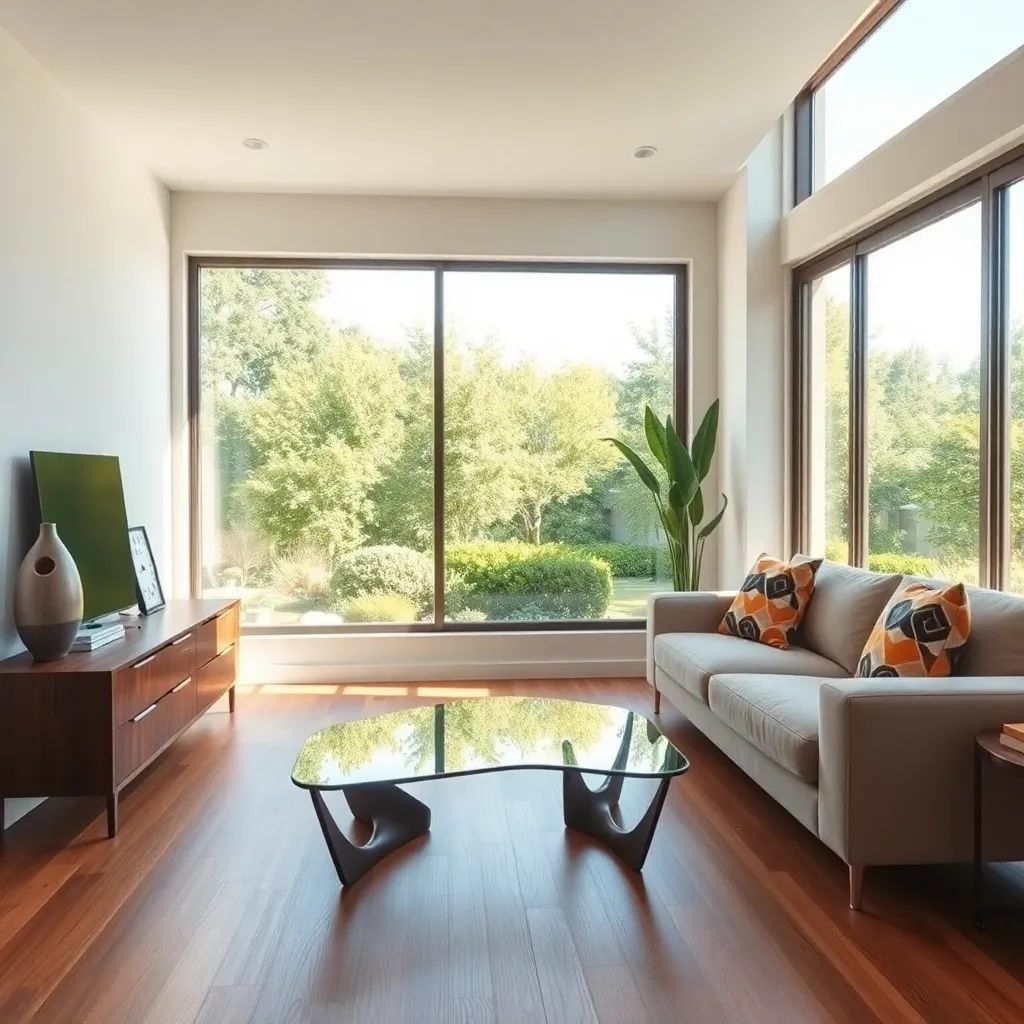
To truly embrace the mid-century modern aesthetic, consider incorporating large glass windows into your space. These windows not only reflect the era’s emphasis on bringing the outdoors in but also flood your home with natural light, enhancing the beauty of your interior furnishings.
Begin by selecting window frames that complement the rest of your decor—sleek, minimal frames in black or natural wood often work best. When placing furniture, ensure that seating arrangements take advantage of the view, allowing the outdoors to become a seamless extension of your living space.
For a more advanced approach, integrate window treatments that enhance the aesthetic without blocking light. Sheer curtains or blinds in neutral tones can offer privacy while maintaining the open, airy feel that large glass windows provide.
Consider the orientation of your windows to maximize energy efficiency and comfort. South-facing windows, for example, can help warm your home in the winter, while strategically placed overhangs or shades can reduce glare and heat during summer months, making your space both stylish and functional.
Conclusion: Growing Success with These Plants
In exploring the ’15 Stunning Mid-Century Modern Interior Tips,’ we uncovered transformative insights to enhance not just our living spaces, but also our relationships. By embracing simplicity, functionality, and thoughtful design, you can create a home environment that fosters open communication and connection. From incorporating natural materials and iconic statement pieces to balancing colors and textures, each tip offers a unique way to reflect your shared story and values within your home.
Now, take immediate action by selecting one tip to implement today—whether it’s rearranging a room for better flow or introducing a new piece of art that sparks joy for both you and your partner. This small step can pave the way for deeper conversations and a stronger bond.
Remember, crafting a harmonious living space is a journey, not a destination. Bookmark this article to serve as your go-to guide whenever you seek inspiration or need a reminder of how your environment intertwines with relationship success. By nurturing both your home and your relationship, you are laying the groundwork for a future filled with love and understanding. Here’s to building a space—and a relationship—that stands the test of time. Save this guide and revisit it often as you continue to create a vibrant, loving home together.
